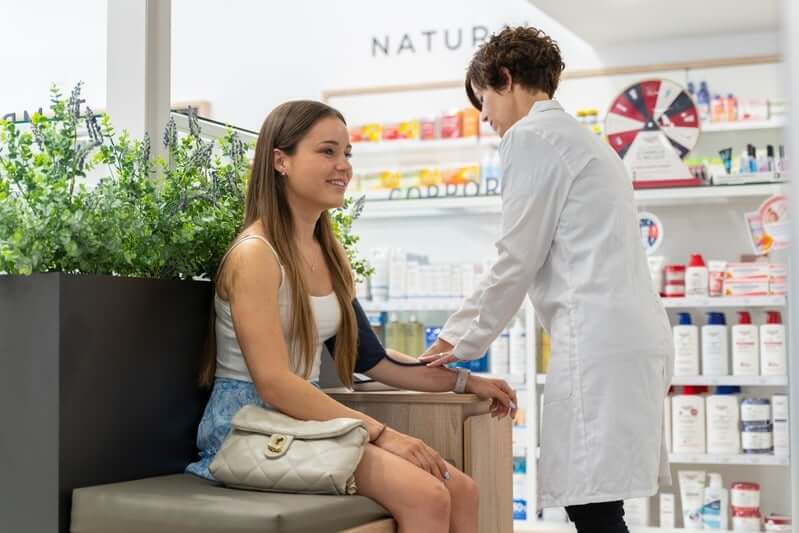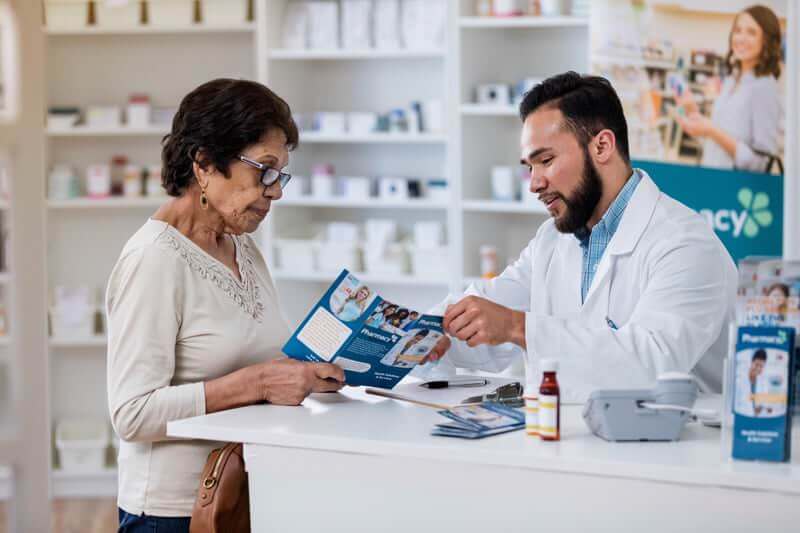The tide is turning in healthcare, and pharmacies are emerging as a powerful new point of care (POC). Patients are increasingly turning to pharmacists for accessible care, medication guidance, and even clinical services. This shift creates a shared value environment: patients gain convenient access to trusted healthcare professionals, healthcare systems find much-needed support in managing patient needs, and brands discover a high-trust environment to reach patients directly and more holistically.
For healthcare marketers, pharmacy point of care marketing presents a strategic opportunity. Pharmacies offer a convenient and trusted environment to engage patients directly, potentially influencing Rx adherence, reporting on patient barriers, and the improvement of treatment outcomes. The following sections delve into the reasons Pharmacy is becoming an essential POC channel to invest in, what you need to know, and how it may influence your healthcare marketing strategy.

The Rise of Pharmacy as a Trusted Healthcare Point of Care
As the role of pharmacists expands, patients are embracing this change with open arms. A recent MM+M survey revealed that a staggering 83% of consumers place a high level of trust in pharmacists’ decision-making regarding medications and treatment. The “Prescription of Trust Report” (Evernorth and Columbia Mailman School of Public Health) further underscores this sentiment, stating, “77.3% of patient respondents agree or strongly agree that the pharmacist is an integral member of the care team. Patients also have a relatively high level of comfort with pharmacists performing clinical activities.”
With the healthcare system strained by physician and nursing shortages, pharmacists are stepping up to the plate. As David Lichtenstein pointed out during a recent panel discussion, “Pharmacists are well-positioned to provide preventive care, disease management, and other patient care services to help bridge this gap.” Patients are actively seeking out clinical services at their local pharmacies, with 81% of healthcare consumers trusting pharmacists to diagnose and prescribe for non-emergency care. (Wolters Kluwer) From blood pressure monitoring to immunizations and disease management, consumers are embracing the convenience and expertise pharmacists offer.

Millennial and Gen Z Healthcare Consumers
Millennials drive healthcare spending, yet affordability concerns heavily influence their healthcare decisions. Millennials are getting sick younger, increasing their share of market spend. As Gen Z enters the consumer base, marketers are wise to maintain awareness that they already track highest for health-mindedness among generations, reportedly “worried about their health preventing them from experiencing everything they’d like to do in life.” (Texas Health) Millennial consumer behavior is driven by a need to cut costs, decrease stress, and optimize convenience. They are also the resident “sandwich generation”, responsible for older generations and kids of their own (even larger market spend). Many don’t even have a primary care provider (Washington Post) and are eager to embrace telehealth, food as medicine, and natural or alternative healthcare. (Abbot | Texas Health) Over 68% use supplements (Forbes).
Millennials are quick to the pharmacy as a point of care. This is a generation that feels busy and reports new levels of anxiety. They want time- and cost-efficient healthcare. In a study on the effects of rising healthcare costs, “Three-quarters of millennials canceled a healthcare appointment after receiving a high cost estimate.” (PYMNTS) They seek advice online, attend support groups, and go to urgent care if needed. (Forbes) Most importantly, they still go to pharmacies and grocery stores: 54% of Millennials have gone to pharmacies for care in the past year (Wolters Kluwer’s) and “consulted as many as seven [digital] information sources for self-diagnosis” (Vonage).
Fun facts on digital healthcare consumption:
- Up to 7% (70K) of all Google searches are healthcare related (Digitalis)
- Nearly 90% of Americans use social media for health information (Healthgrades)
- The CDC reports 58.5% of all adults looked for health or medical information online over 2 months (2022)
Facts About the Wellness Generations
- Millenial and Gen Z Consumers would reduce spend on fashion (62%) and streaming services (36%) to budget for healthier food (Athletec News)
- Health and Wellness is ranked most important (53%) second only to family (79%) (Sanford Health) by Millenials Gen Z
- Millennials favor integrative health, with growing skepticism over Rxs (Millennial Magazine)
Pharmacies as a Modern Point of Care
Millennials are the Connected generation, informed by social media. The risk of losing Millennial healthcare consumers to digital-first, retail, or influencer-informed healthcare alternatives is real. Embracing Millennial healthcare consumers requires understanding their healthcare journey, preferences, and sources of authority. Integrating apps, digital reminders, and other tools can help increase patient engagement. Many pharmacies are embracing app-augmented care and prescription fulfillment for in-person and delivery touchpoints.
70% of Americans who are consumers have gone back into the physical store location for a pharmacy interaction. So the ability to be what we call, at CMI media group, being phygital-- being both physical and digital--is incredibly important for the advertiser for the manufacturer to be able to properly communicate to the patient and the consumer.
Pharmacists, particularly in grocery store settings, have a unique opportunity to create more holistic and effective treatments by pairing prescription medications with over-the-counter (OTC) products and lifestyle support. For example, a pharmacist treating a patient with diabetes can recommend OTC products like glucose monitors and nutritional supplements, and provide guidance on healthy eating habits and exercise. This holistic approach can lead to better treatment outcomes and improved patient satisfaction.
Rx Lift at the Pharmacy Level
As the pharmacy takes up a growing amount of frontline healthcare, there is tremendous opportunity to ease dropoff. 9M Americans are not picking up their prescriptions, according to the Centers for Disease Control. And when they do, they often lower the dose or delay refills. (Health) While costs are the major driver of drop-off, other reasons for Rx nonadherence (AMA) can be solved at the pharmacy level:
- Fear of side effects
- Real expectations around need and window of effect
- Too many medications
- Lack of symptoms / imperceivable symptoms
- Mistrust in HCPs / pharma
- Dependency concerns
- Feelings of isolation or depression
Pharmacists can respond to these concerns with personalized education and support. They can use technological or analog medication reminders and create an understanding about prescriptions and interactions. As Brett Barker of NuCara Pharmacy notes, “Pharmacy can really fill a gap, because we’re one of the components that has a better picture of everything going on than other points in the healthcare system.”
Relationships Increase Receptivity
The community brick-and-mortar pharmacy sits advantageously in the midst of where people live: 90% of all Americans live within 5 miles of a pharmacy (Wokters Kluwer). Patients increasingly want personalization, but get little time with providers. According to the American Medical Association, patients generally only remember 50% of a healthcare visit (AMA). Pharmacists play an important interstitial role, able to see the entire prescription history of a patient, build trust with embedded daily presence (NCBI), respond to context clues, and leverage relationships to increase patient receptivity to information that is critical to adherence. Transparency and clear understanding of what a medication does and what to expect during treatment, including side effects, help build patient adherence. (AMA) .

According to a healthcare consumer study by CVS, the pharmacist can alleviate psychological reticence around medications as a trusted authority. Patients talk to their pharmacists about Rx concerns, including:
- Side effects (73% of respondents)
- Proper use of medications (72% of respondents)
- Medication interactions (70% of respondents)
Healthcare marketers can amplify pharmacist impact by supporting pharmacy education and informational materials that are attuned to their patient demographics and conditions.
Nudging Adherence at the Point of Care
Personalizing informational materials to inform or be given by the pharmacist at the point of care can offset nonadherence. Already trusted, primed pharmacists can listen for, anticipate, and respond to patient concerns to positively nudge them to take their medicine.
“Nudging can be applied to side effects nonadherence by using informational nudges. These provide scientific and rational logic regarding how medications work for specific patient conditions, how side effects can be managed and are temporary, that serious side effects are rare, and that serious effects regarding a condition can occur without treatment.” (RxLive)
Simple informational nudges can be crucial in counterbalancing emotional contributors, personal conditions, and misinformation that discourages people from taking medicine. In one 12-month trial, patients had 6 times more positive responses than negative when simple nudges were integrated into cardiovascular prescriptions.
Navigating Growth Obstacles
While the expanding role of pharmacies holds great promise, there are obstacles to overcome. Pharmacies need to be profitable without losing their role as an affordable and convenient patient point of care. That means expanding services and getting the word out about it, rather than staying holed into distribution-only models. Increased workloads need solutions that don’t take away the time with patients. Another pressing issue is pharmacist and pharmacy staff burnout. “Pharmacists report overwhelming emotional exhaustion from pressures to move quickly, heavy workloads, and lack of staff.” (Pharmacy Times)
The Path Forward: Omnichannel Strategies and Collaborative Innovation
To effectively navigate the evolving pharmacy landscape and drive meaningful patient engagement, healthcare marketers must adopt an omnichannel approach that leverages both digital and in-person touchpoints. Jacob Harrison emphasized this point, stating, “70% of Americans who are consumers have gone back into the physical store location for a pharmacy interaction. So the ability to be what we call at CMI media group, being phygital, being both physical and digital, is incredibly important for the advertiser, for the manufacturer to be able to properly communicate to the patient and the consumer.”
Successful patient engagement will require close collaboration between healthcare marketers, pharmacies, and technology partners. Beth Zemkoski emphasized this, stating, “Regardless of the brand or disease state, there are areas of opportunity to be flexible and be agile.” By fostering open communication, shared learning, and joint innovation, stakeholders can develop solutions that address the unique needs and challenges of engaging patients at the pharmacy point of care.

Conclusion
As pharmacies and pharmacists take on a more central role in healthcare journeys, healthcare marketers have a unique opportunity to partner with these trusted providers to drive better patient engagement and outcomes. By leveraging the power of technology, omnichannel strategies, and collaborative innovation, marketers can help pharmacies overcome challenges and deliver on the promise of accessible, high-quality care. Prioritizing empathy, agility, and collaboration will position those who navigate this transformation effectively to make a meaningful impact on patient lives and drive brand success.
Key Takeaways for Healthcare Marketers
- Recognize the growing influence of pharmacists as trusted healthcare providers and leverage this trust to deliver meaningful patient education and support to pharmacists and patients surrounding and at the Pharmacy POC.
- Adapt marketing strategies to the preferences and needs of Millennial and Gen Z healthcare consumers, who prioritize convenience, integrative approaches, cost-effectiveness, and digital engagement.
- Address skepticism through transparency and evidence-based information, particularly when targeting Millennial and Gen Z audiences, addressing concerns head-on.
- Collaborate with pharmacies to develop targeted adherence programs, informational nudges, and patient support materials that address common barriers to medication adherence.
- Embrace omnichannel strategies that seamlessly integrate digital and in-person touchpoints to create a cohesive and impactful patient experience.
- Foster partnerships with POC providers and pharmacies to drive innovation and develop solutions tailored to the unique challenges of the pharmacy point of care.
